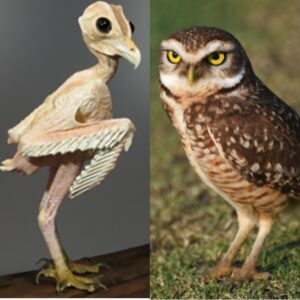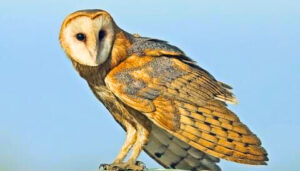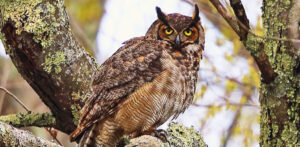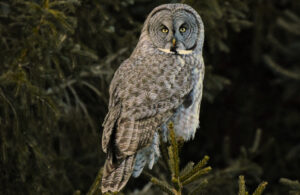Because of their unusual plumage, owl without feathers are one of the more identifiable birds in the world. An owl’s ability to fly silently, act as insulation, and disguise itself is all made possible by its feathers.

Owl Without Feathers seem nearly unrecognizable, which contradicts popular belief about what an owl actually looks like. Not only is the sight of an owl without feathers striking because it deviates so much from the norm, but it also serves as a sharp reminder of the intricate workings of nature and the animal kingdom’s use of form to function.
Types of Owl Feathers
Feathers are essential to an owl’s existence since they help with flight, insulation, and disguise. The plumage of owls is characteristic and varies from species to species, but it consists of three types of feathers: flight feathers, down feathers, and contour feathers.
Flight Feathers:
Located on the tail and wings, are strong and wide, enabling the required lift and airborne mobility. Owls have one special characteristic: the leading edges of their main flight feathers are fringed, which reduces noise from air passing over them and allows for silent flying.
Contour Feathers:
Give the owl its distinctive form and conceal its body. The owl can make less noise when flying because to these waterproof and aerodynamic feathers, which is an essential characteristic for sly hunting.
Down Feathers:
Are cushiony and tucked under the owl’s contour feathers, keeping it warm in chilly regions. For birds to survive in a variety of weather circumstances, they aid in controlling body temperature.
Feather Type Function Feature
Contour Shape, waterproofing Noise reduction during flight
Down Insulation Regulates body temperature
Flight Lift, maneuverability Fringed edges for silent flight
Molting is the process by which an owl sheds its old feathers and grows new ones. For the feathers to perform their jobs as effectively as possible, this cycle guarantees that they are maintained in ideal condition. The owl may continue to fly and defend itself during its progressive molting process.
Owl feathers, which vary in hue and pattern, are also a great means of camouflage, helping to conceal the owl from both predators and prey by blending into their surroundings. An owl’s plumage enhances their visual appeal in addition to serving a practical purpose.
How long do owls live
Barn Owl: 4-9 years in the wild, up to 15 years in captivity. Great Horned Owl: 10-13 years in the wild, over 25 years in captivity. Snowy Owl: 7-10 years in the wild, over 30 years in captivity. Barred Owl: 8-10 years in the wild, over 20 years in captivity.
Owls Without Feathers Look Like:
Given that their feathers play a major role in both their size and appearance, owls without feathers seem even more unlike other featherless birds. A chicken that has had its feathers plucked can resemble an owl, demonstrating the significance of feathers in giving an owl its majestic appearance.
When an owl is devoid of its feathers, its appearance differs greatly from its familiar appearance, displaying a form and structure that may be seen as strange or even alien, as seen below.
Barn Owl Without Feathers:
The Barn the owl house has a very distinct appearance when it is featherless. The barn owl without feathers seems less beautiful and more alien. Barn owls are usually recognized for their heart-shaped faces and graceful stance. It’s a featherless sight, with a skinny body and a huge, disproportionately sized head relative to the rest of its body.
Author Dana Schwartz started a viral phenomenon in 2017 when she posted on Twitter about her surprise at seeing what featherless barn owls looked like. This popular video lifted the veil on these enigmatic animals, exposing a rarely seen aspect of owls and emphasizing how essential feathers are to their identity and survival.

Great Horn Owl Without Feathers:
Given its height and stature, a Great Horned owl house without feathers would seem much more menacing. When wearing feathers, these owls have a formidable presence; when they don’t, their strong build and large talons are more noticeable. The great horned owl’s actual build, which is suited for hunting and survival, is revealed by its lack of feathers, highlighting the incredible force of these birds.

Great Grey Owl Without Feathers:
This striking and instructive drawing of a Great Gray Owl devoid of feathers is impressive. These big birds are not as bulky as their fluffy coat suggests, despite the fact that it may seem impossible. The Great Gray Owl’s size is really mostly misleading because much of its heft comes from its feathers rather than its actual body mass.
A Great Gray Owl without feathers may appear strange or even humorous, yet it serves as a clear reminder of how important feathers are to bird survival.

Owls Without Feathers Are Real or Not?
Indeed. A hairless owl is a real animal. Owing to their peculiar appearance, some would assume they are made up and nonexistent. However, that is untrue. If you still find it hard to believe, try keeping an eye out for them in the sky at dawn or dusk.
Because they are nocturnal, they are active during this period. It’s possible that you’ll notice them, which will confirm their existence. To assist you discover the truth, I will also tell you when featherless owls are most active and how to view them.
How Can I Spot An Owl Without Feathers?
The look of hairless owls differs from that of regular owls. They appear strange and odd. Thus, it makes sense that we would be curious to see a featherless owl.
- In clear weather, try to identify a featherless owl. They dislike windstorms and rain. You won’t see them, therefore, if you choose poor weather. They stay in cavities during this period.
- Pick an area where bare-chested owls hunt. They primarily hunt in farmlands, cities, hedgerows, etc. You could see them over here.
- The greatest time to see a naked owl is in the winter. We are unable to locate featherless owls at night since they are nocturnal birds of prey. throughout the winter, the featherless owls hunt throughout the day. If it is winter, you can attempt to find them throughout the day as well.
- A featherless owl can also be seen perching on roadside vegetation. Typically, the best times to see them are at dusk and sunrise. This time, they continue to be active. In order to see them, you can venture outside at nightfall or dawn.
Are Owls Without Feathers Friendly?
Featherless owls have no amiability toward humans. And that also applies to regular owls. They have an aggressive disposition. You should use caution even if there aren’t many stories of their assaulting or hurting people.
- They consider others to be their adversaries. It’s clear from this that they won’t like you or want to be friends with you.
- They lack a feeling of commitment.
- They dislike being around people.
- They object to being touched.
- They are very less affectionate to people.
Conclusion:
Normal owls and featherless owls are not the same species. It is for this reason that people are interested in it. Because of their small heads, large eyes, and longer legs than their bodies, these owls without feathers have a frightening appearance. A person would be enough horrified by this appearance, especially at night.
For more information: Visit our Homepage

